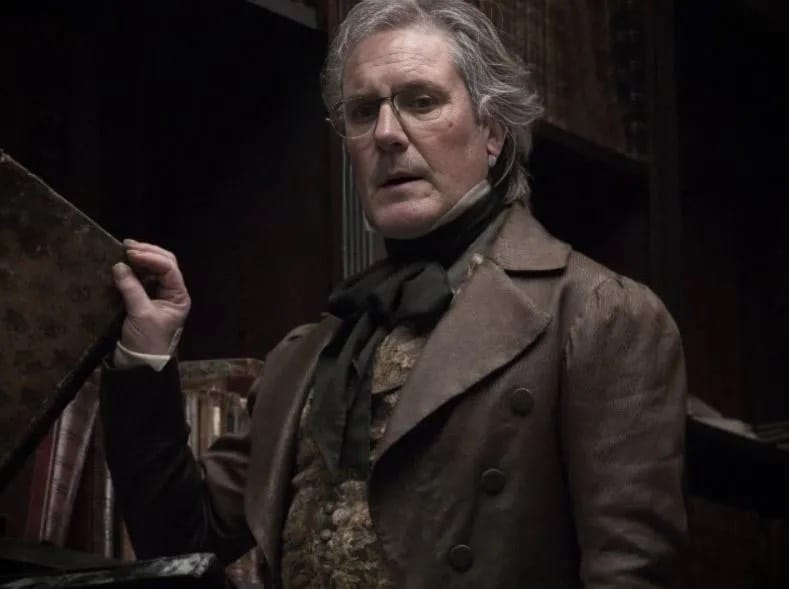VISIONS OF JOHANNA

The true villain of Stephen Sondheim's musical theatre masterpiece Sweeney Todd is not the demon barber of Fleet Street himself, but rather the morally corrupt Judge Turpin, who has Sweeney (originally Benjamin Barker) imprisoned on false pretenses so that he can pursue his pretty wife, Lucy.
After Turpin sexually assaults Lucy at a sinister masked ball held at his home, she suffers extreme trauma from the incident, goes completely insane, and is finally locked up in an asylum, where she is cruelly separated from her daughter, Johanna. To make matters worse, Judge Turpin takes in Johanna as his ward, keeping her under lock and key.
Many years later, Benjamin Barker returns from a penal colony in Australia to plot his revenge on Turpin, assuming the alias of 'Sweeney Todd' so that no one will suspect his true identity and murderous intentions. Arriving by boat with fellow sailor Anthony Hope, Todd and his young companion part ways, not realising that their fates will later intertwine through Johanna.
Visions of Johanna
I feel you, Johanna
I feel you,
I was half convinced I'd waken,
Satisfied enough to dream you
Happily I was mistaken
Johanna
The fascinating thing about the three times Johanna is featured prominently as the central theme of songs in Sondheim's musical is that the psychological colour and tone change according to whose perspective of Johanna is being sung.
In Act One, Anthony sings the first variation of "Johanna" as a more traditional-style romantic ballad inspired by his first sighting of her gazing out from beyond her bedroom window in Judge Turpin's austere townhouse, which immediately sets the young man's heart ablaze with romantic longing for her. This is written in a similar vein to Lerner and Loewe's "On the Street Where You Live" from My Fair Lady (1956), and it is comparably set up as a scene with the admiring young suitor out on the street while expressing his feelings for the subject of his affections inside. In many ways, Sweeney Todd has often seemed to me to be the soot-dark London prequel to My Fair Lady, where we transition from the Edwardian era to the Victorian era, from Wimpole Street to Fleet Street. One could even imagine an alternative universe where an Eliza Doolittle-type flower girl ends up running a pie shop.
Both musicals deal with social and cultural issues in starkly different ways, but I certainly wouldn't be surprised if Sondheim were paying some sort of twisted homage to that great musical adaptation of Shaw's Pygmalion. You can hear it in Anthony's sincere pining for Johanna, which is not so dissimilar from Freddie Eynsford-Hill's song of romantic infatuation toward Eliza Doolittle.
Mea culpa, mea culpa,
Mea maxima culpa,
Mea maxima maxima culpa!
God deliver me! Release me!
Forgive me! Restrain me! Pervade me!
Later in Act One, Judge Turpin sings his controversial and often cut "Johanna (Mea Culpa)," where he reveals his sinister and twisted obsessive desire for the young lady living in his home. In contrast to Anthony's earlier, more innocent expression of love for Johanna, Judge Turpin sings his "Johanna" while he self-flagellates himself to orgasm in an attempt to simultaneously atone for his inappropriate and predatory feelings toward her. The judge concludes that the best outcome is for him to marry Johanna in order to "protect her" from others, justifying his sexual desire through his oppressive form of control.
It is a highly disturbing scene, as it demonstrates Turpin's authoritarian nature and his possessive sense of entitlement toward Johanna. Having already used his position of power to destroy her parents, Benjamin and Lucy Barker, the chilling control he has over Johanna deepens the psychodrama he created through his original lust for her mother. This signals to the audience that Turpin desires a new, younger image of Lucy to violate while forgetting that Johanna is also the daughter of Benjamin Barker (Sweeney), whom he managed to have exiled from England.
And are you beautiful and pale, with yellow hair, like her?
I'd want you beautiful and pale, the way I've dreamed you were,
Johanna (Johanna)
And if you're beautiful, what then, with yellow hair, like wheat
I think we shall not meet again my little dove, my sweet
Johanna (I'll steal you, Johanna)
And finally, during Act Two, in the third cumulative "Johanna," we find a quartet of characters—Anthony, Johanna, Sweeney (Benjamin), and the Beggar Woman (Lucy)—who combine their various perspectives in one multi-layered scene. In this ingeniously devised quartet, Anthony goes in search of Johanna, who is becoming increasingly afraid, while Sweeney continues to slit throats in his barbershop, dreaming of seeing his daughter again. Meanwhile the Beggar Woman (Lucy) warns passing members of the public to stay away from the smell of fire and smoke coming from the ovens of Mrs. Lovett's pie shop, which essentially serves as a crematorium for the remains of Todd's victims.
By having the two 'couples' sing, we have what might be perceived as a macabre "family" quartet of sorts, although each of the characters in this scene is locked into their own focus and not fully aware of the co-joined fate they all now share. Perhaps the tragic irony of Sondheim's "Sweeney Todd" is that Anthony and Johanna might finally be free to share a life together, though they will be forever haunted by the deaths of Benjamin (Sweeney) and Lucy (the Beggar Woman), as their future is now built on the smouldering pyre of the past.